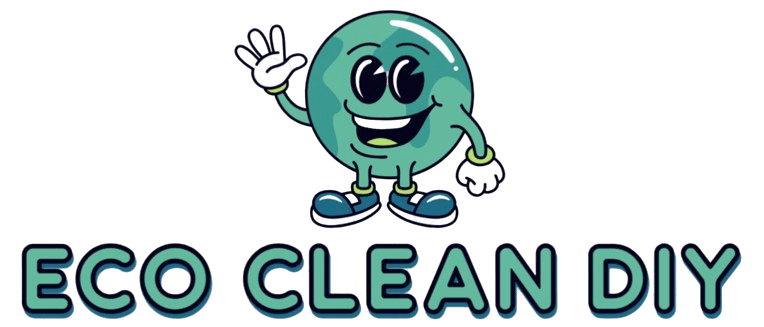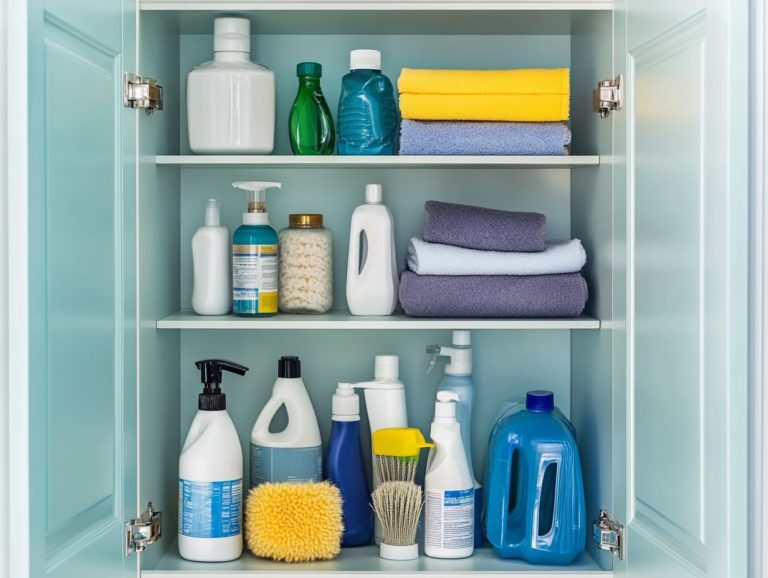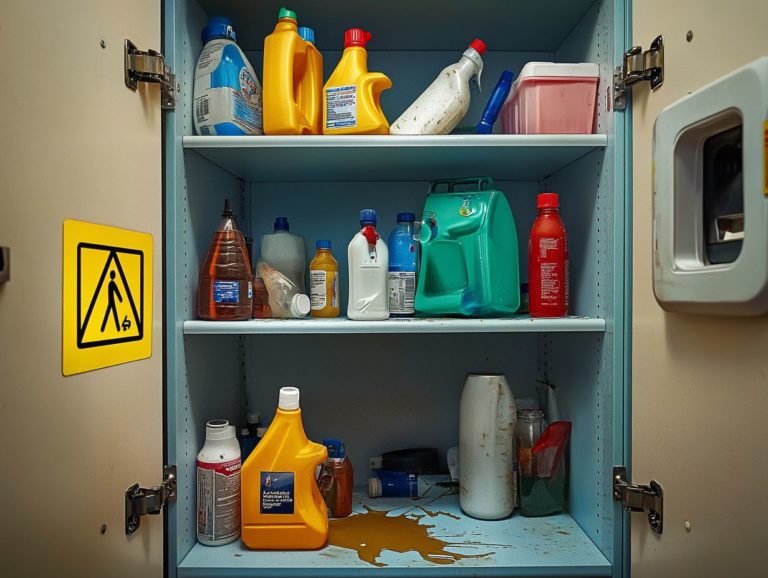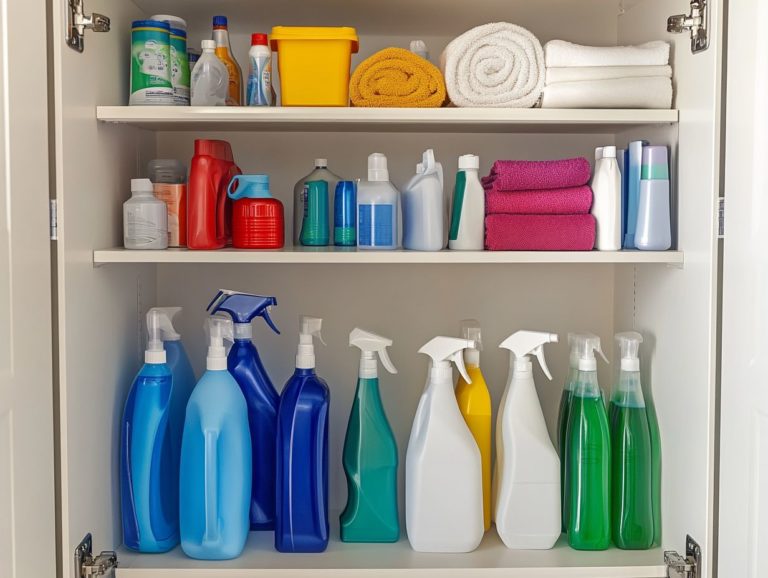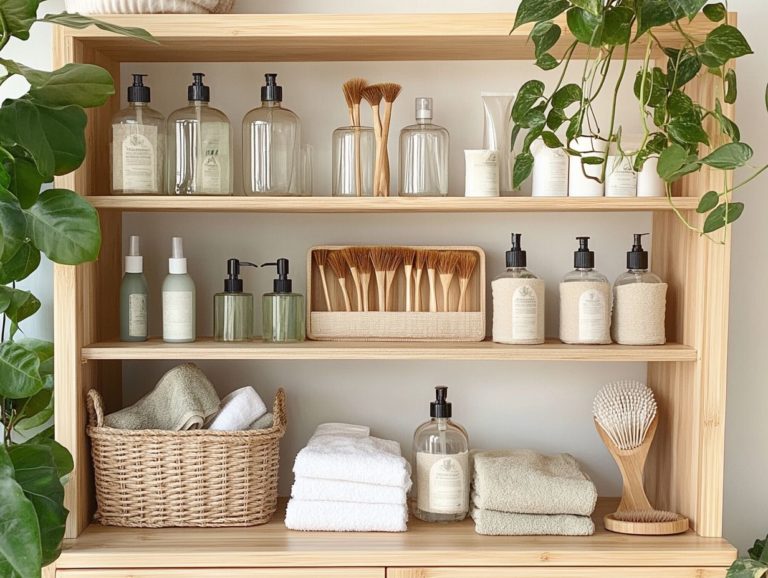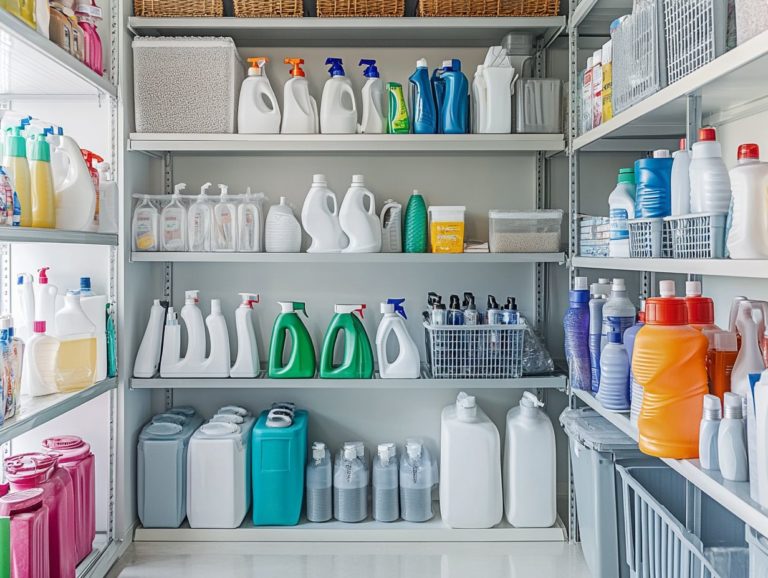How to Store Your Cleaning Tools with Care
Properly storing your cleaning tools and supplies is vital for extending their lifespan and keeping your home neat and organized.
From the humble broom and mop to specialized vacuum cleaners and steam cleaners, each cleaning product demands particular care to ensure optimal performance.
This article delves into the diverse types of cleaning tools, explores effective storage methods, outlines necessary safety measures, and provides valuable storage tips for maintaining these essentials.
Uncover the secrets to keeping your cleaning arsenal in prime condition, ensuring it s always ready for action when you need it most. Learn from professional organizing experts and decluttering specialists to optimize your home organization.
Contents
- Key Takeaways:
- Why Is Proper Storage of Cleaning Tools Important?
- What Are the Different Types of Cleaning Tools?
- Storing Basic Cleaning Tools
- How to Store Specialized Cleaning Tools?
- What Are the Safety Measures for Storing Cleaning Tools?
- How to Properly Clean and Maintain Cleaning Tools?
- Frequently Asked Questions
- 1. How do I properly clean and maintain my cleaning tools before storing them?
- 2. How should I organize my cleaning tools when I store them?
- 3. How often should I replace my cleaning tools?
- 4. Can I store all of my cleaning tools together in one place?
- 5. How can I protect my cleaning tools from getting damaged during storage?
- 6. Is it necessary to clean my storage area for cleaning tools regularly?
Key Takeaways:
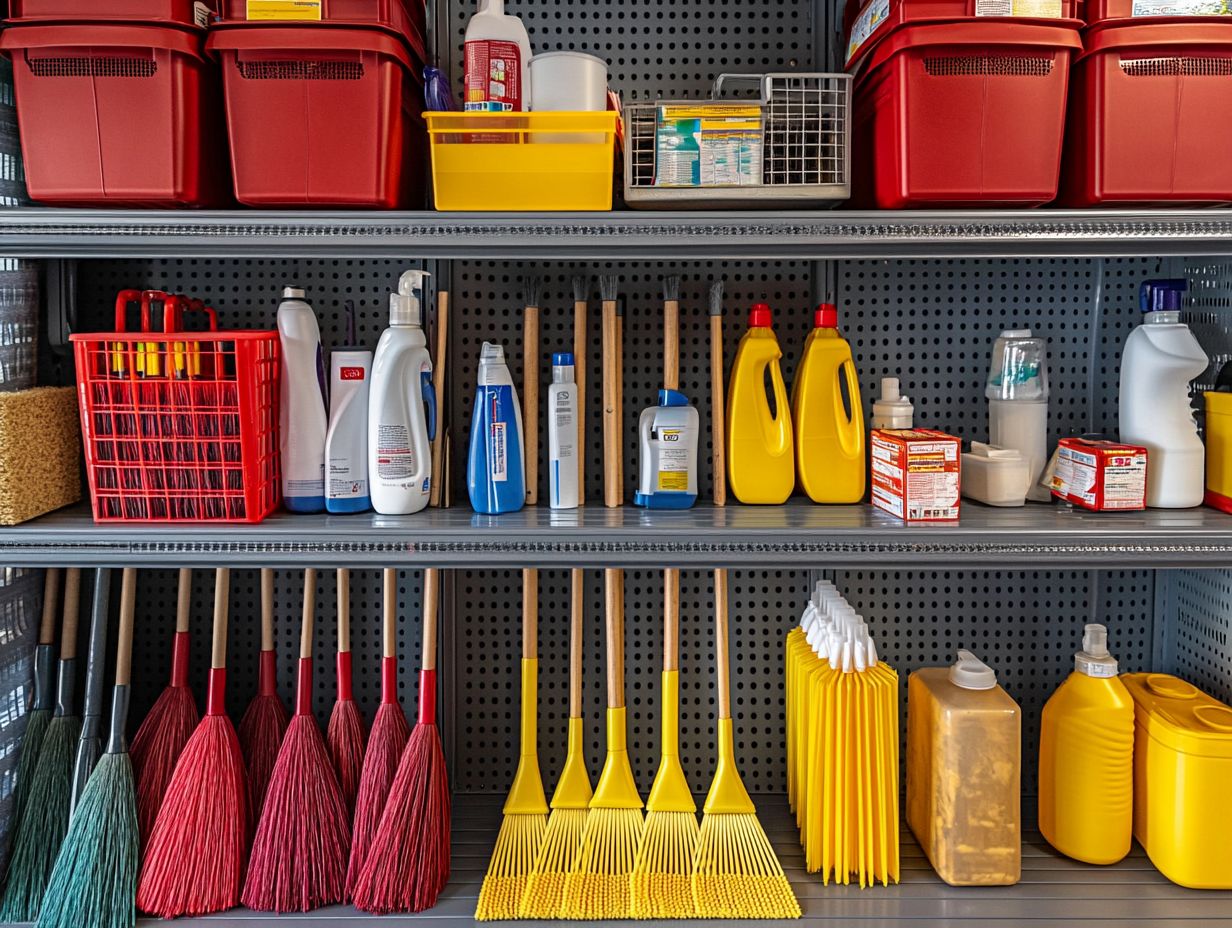
- Properly storing cleaning tools prolongs their lifespan and ensures effectiveness.
- Basic tools like brooms and sponges should be stored upright in a dry place; specialized tools like vacuums should have their designated areas.
- Regularly check for damage, keep tools out of children s reach, and sanitize them after use to maintain quality and safety.
Why Is Proper Storage of Cleaning Tools Important?
Proper storage of cleaning tools is crucial for keeping your home clean and organized. It ensures that your cleaning products are easily accessible for daily tasks while minimizing safety concerns, especially in homes with young children.
By implementing efficient storage methods, you can make the most of your utility closet space, prevent the misuse of cleaning chemicals, and promote a more systematic approach to home organization just as professional organizers like Mary Cornetta from Sort and Sweet advocate.
This practice transforms your living space into the clean haven you ve always wanted! It also fosters a sense of order and cleanliness that significantly enhances your overall quality of life.
What Are the Different Types of Cleaning Tools?
You have a wide array of cleaning tools at your disposal, each designed to meet specific cleaning needs. This variety can elevate your efficiency when tackling various tasks around your home.
Recognizing the difference between basic tools like brooms, mops, and sponges and specialized equipment such as vacuum cleaners and carpet cleaners can profoundly enhance your cleaning routine and overall home organization.
Each type of tool serves a distinct purpose, allowing you to maximize the potential of your cleaning products and maintain a pristine environment in every corner of your home.
1. Basic Tools
Basic tools are the backbone of your cleaning arsenal, offering essential methods for maintaining cleanliness in your daily tasks. Items like brooms, mops, sponges, and cloths are essential for effective cleaning routines, allowing you to quickly tidy up various surfaces throughout your home.
Investing in high-quality basic cleaning tools can elevate your overall cleaning process, transforming your space into a more organized and inviting haven. Use organizing tips from experts to keep these tools efficiently stored.
Each of these tools fulfills a specific role; for example, brooms are perfect for sweeping away debris, while mops tackle larger spills and messes on hard floors. Sponges offer incredible versatility, ideal for scrubbing surfaces without scratching, and microfiber cloths excel at trapping dust and dirt without the need for harsh chemicals.
To ensure the longevity and efficiency of these cleaning supplies, proper maintenance practices are key. Regularly washing and air-drying your cloths and sponges helps prevent bacterial growth, while storing tools like brooms and mops in a dry area keeps them in peak condition. This diligent care ultimately contributes to a more organized and pristine home environment.
2. Specialized Tools
Specialized tools are crafted to address specific cleaning challenges, making them essential for achieving a truly deep clean in your home. Tools like vacuum cleaners, carpet cleaners, and steam cleaners offer advanced solutions that tackle stubborn dirt, allergens, and bacteria issues that basic cleaning tools often miss.
By mastering the effective use of these specialized products, you can significantly elevate your home’s hygiene and overall atmosphere. For example, vacuum cleaners equipped with HEPA filters (High-Efficiency Particulate Air filters that trap small particles) can capture even the smallest particles, ensuring improved air quality in your space.
Meanwhile, carpet cleaners employ powerful extraction methods to eliminate embedded stains and odors that can linger in your carpets. Steam cleaners take it a step further by using high temperatures to disinfect surfaces without relying on harsh chemicals, promoting a healthier cleaning routine.
Want to keep your cleaning tools working like new? Proper maintenance is key. Regularly empty vacuum bags, clean filters, and descale steam cleaners to keep them in top shape. Providing proper storage helps protect your tools from damage, ensuring they remain effective for all your future cleaning endeavors.
Storing Basic Cleaning Tools
Storing your basic cleaning tools and products properly is essential for maintaining an organized space and ensuring you can access them quickly when the need arises. By using effective storage strategies like utilizing the utility closet, designating specific spots for brooms, mops, sponges, and cloths, and adding organizing systems such as hooks and baskets you can significantly streamline your cleaning routine.
Use labels to keep everything in its place. A well-organized storage solution not only boosts accessibility but also fosters an overall sense of order and cleanliness in your home.
1. Brooms and Mops
Brooms and mops are essential allies in your quest for spotless floors and surfaces, and how you store them can significantly extend their lifespan and effectiveness. Consider using vertical storage solutions like wall hooks or dedicated compartments in your utility closet. This approach not only keeps your cleaning tools organized but also ensures they re easily accessible for your daily cleaning rituals.
By maintaining a dry and clean environment for your tools, you effectively prevent damage and simplify the task of upholding a hygienic home. Adding storage bins or baskets can elevate your organization even further, providing a designated spot for each tool, including dustpans and microfiber cloths.
Opting for materials that resist moisture and dirt can enhance overall hygiene, ensuring your cleaning gear remains as pristine as your living space. For those navigating limited space, magnetic strips or mounted racks can be transformative, elevating brooms and mops off the floor and out of the way.
When your cleaning tools are always within arm’s reach, you’re more likely to engage in regular maintenance, leading to a consistently tidy environment that you can take pride in.
2. Sponges and Cloths
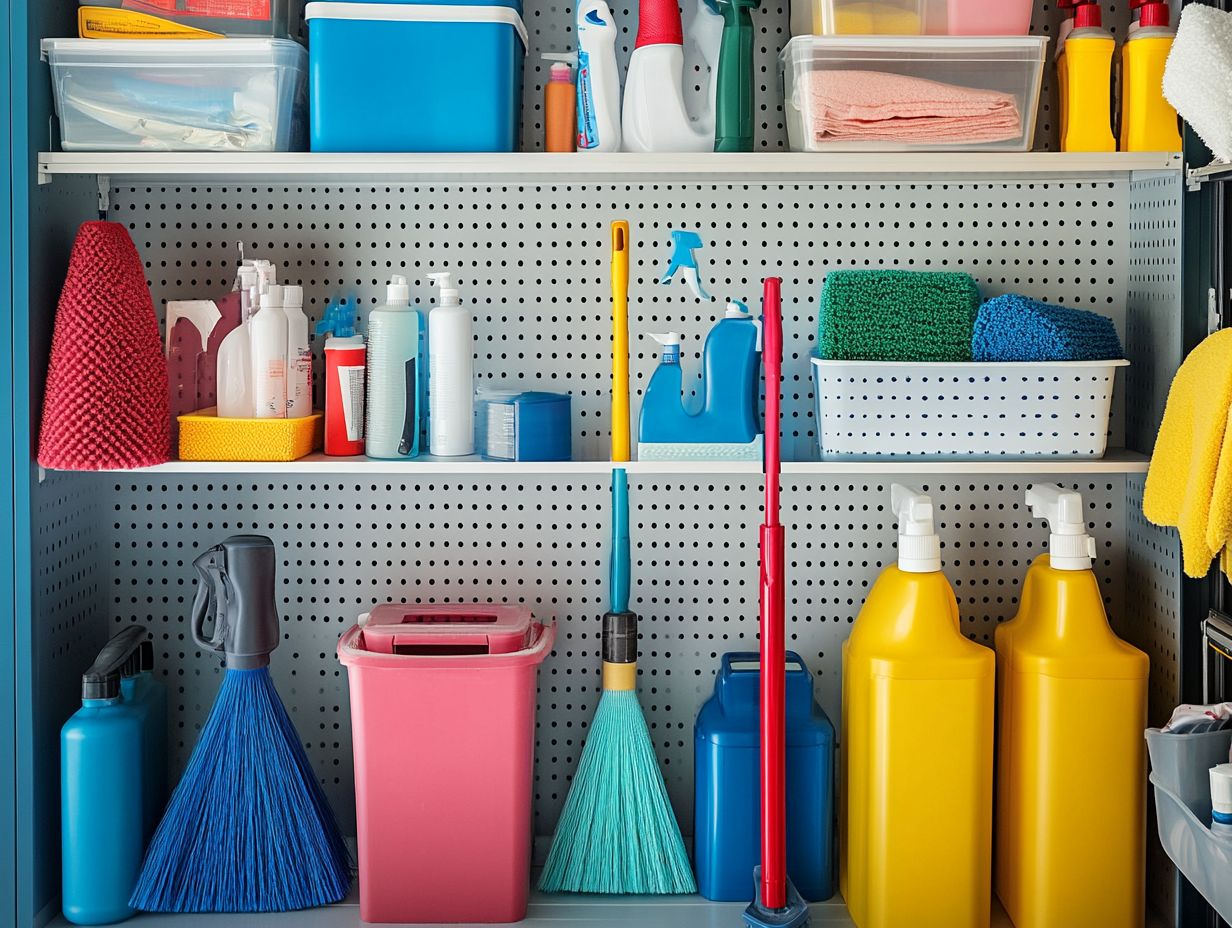
Proper storage of your sponges and cloths is essential for preventing bacteria growth and ensuring their effectiveness in your cleaning tasks. By keeping these items in a well-ventilated area, ideally in a designated container or organizer, you allow them to dry properly and avoid any unpleasant odors.
Regularly changing and cleaning these items will further enhance hygiene and contribute to the overall cleanliness of your home environment. Consider using a shelf or hooks in your cleaning supply area to make these essential tools easily accessible whenever you need them.
It’s also beneficial to categorize your storage solutions creating separate spaces for sponges, microfiber cloths, and other cleaning implements can streamline your routine significantly. Adding breathable mesh bags or caddies can facilitate airflow while reducing moisture retention.
This thoughtful organization promotes hygiene and boosts your efficiency during cleaning sessions, ensuring that everything you need is readily available when tackling daily cleaning tasks or larger deep-cleaning projects.
3. Dustpan and Brush
A dustpan and brush are essential for quick clean-ups. Store them in a way that keeps them accessible and organized.
Use a specific container or a magnetic strip in your utility closet. This ensures they re easy to find and ready for action at any time.
Keep them clean and free of debris to maintain their effectiveness. Rinsing the brush after each use and wiping the dustpan clean extends their lifespan.
Hanging the dustpan and brush on a wall hook maximizes vertical space. Store these essentials close to high-traffic areas, like the kitchen or entryway, to streamline your cleaning process.
How to Store Specialized Cleaning Tools?
Storing specialized cleaning tools requires attention to detail. Proper storage preserves functionality and extends the lifespan of your tools.
Store vacuum cleaners, carpet cleaners, and steam cleaners in designated areas. Protect them from damage while keeping them accessible for when you need them.
Consider using shelving units or cabinets to keep these tools organized. This reduces clutter and enhances your overall cleaning efficiency.
1. Vacuum Cleaners
Vacuum cleaners are essential for keeping your carpets and floors pristine. Store them upright in a dedicated space, like a closet or utility area, to prevent damage.
Using tool caddies can keep attachments organized and in one place. This makes it easier to find what you need for your cleaning tasks.
Create distinct zones within your storage area for different cleaning tools. This way, your vacuuming supplies are easily accessible alongside mops, brooms, and spray bottles.
Wall-mounted hooks are beneficial for hanging smaller units or hose attachments. They help keep everything untangled and tidy.
Regularly clean and declutter your storage space to enhance accessibility. Proper labeling of storage bins allows for quick retrieval of cleaners and components.
2. Carpet Cleaners
Carpet cleaners need special attention to keep all components intact. Place them in a dry, cool area with good ventilation to prevent moisture buildup.
Use dedicated shelves or cabinets to keep your carpet cleaners organized and easy to access. This is crucial for routine maintenance or unexpected cleaning emergencies.
Store your cleaning solutions and specialized tools in labeled containers. This practice allows for quick identification during urgent situations and minimizes risks.
Maintain a consistent temperature and avoid direct sunlight to extend the lifespan of your cleaner and its solutions. Following these best practices leads to more effective cleaning and a less stressful experience.
3. Steam Cleaners
Steam cleaners are excellent for sanitizing and deep cleaning various surfaces. Store them upright in a designated area to protect their components and prevent leaks.
Keep the user manual and accessories organized for easy access. This organization enhances your overall cleaning experience.
Properly organizing your steam cleaning equipment ensures you’re always ready for action. Use storage bins or shelves dedicated to cleaning products to streamline your process.
Clearing small spaces where the steam cleaner is stored reduces clutter and enhances safety. Using protective covers can also safeguard your steam cleaner from dust and damage.
What Are the Safety Measures for Storing Cleaning Tools?
Using safety tips for storing cleaning tools is crucial to mitigate risks, especially concerning child safety. Securely store all cleaning products, particularly strong cleaning agents, out of children’s reach.
Following safety guidelines from organizations like OSHA helps maintain a secure environment. OSHA (Occupational Safety and Health Administration) sets guidelines for safety in the workplace and promotes a clean and organized home.
1. Keep Out of Reach of Children
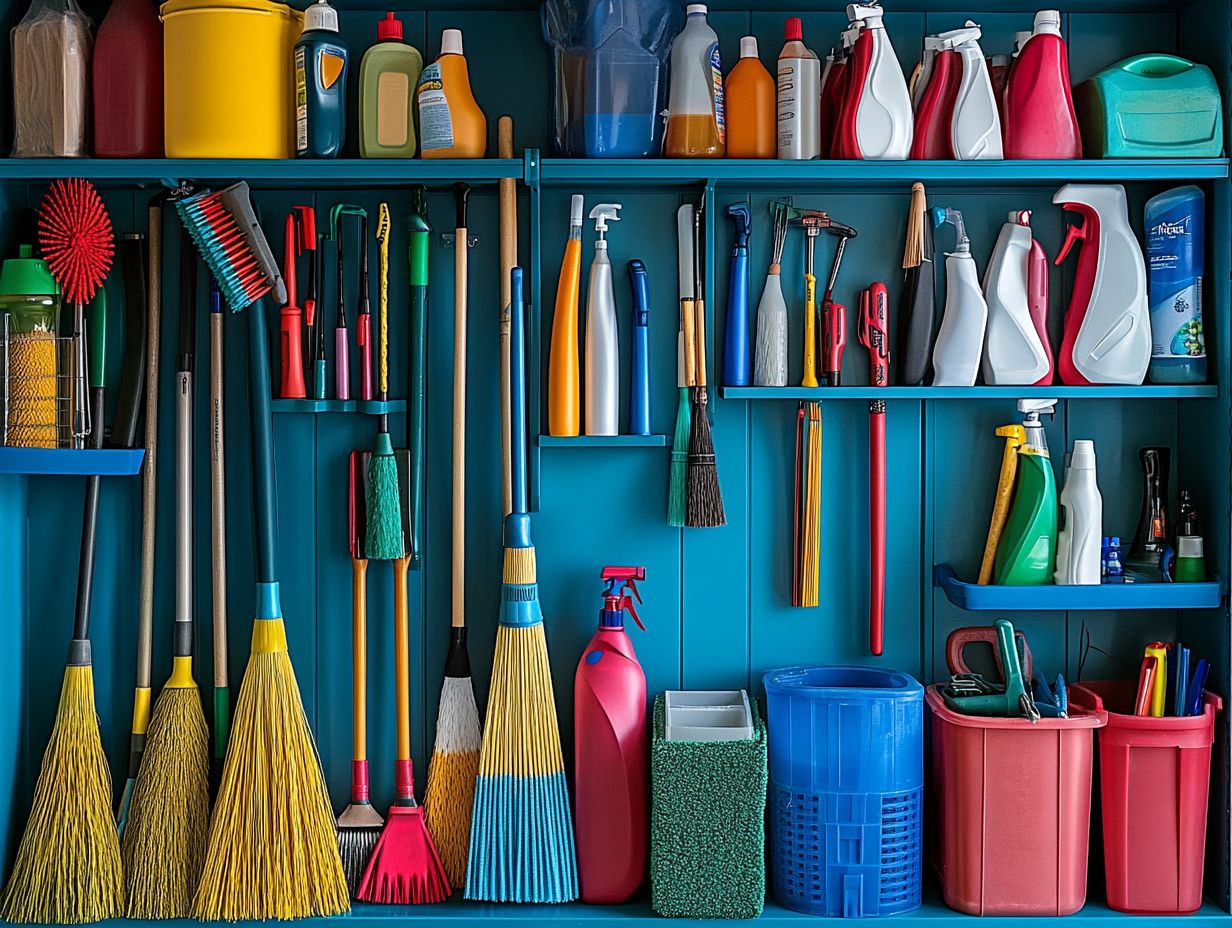
Store cleaning tools and products out of children’s reach. Place cleaning supplies with harsh chemicals in locked cabinets or on high shelves.
Educate children about the dangers of these items and explain why they are not toys. Use role play to demonstrate safe behaviors.
Label containers clearly and maintain a cleaning checklist to reinforce safety. Regularly organize supplies to eliminate potential access points.
These proactive measures help create a safe space for children to thrive. Refer to sources like Martha Stewart Living and Real Simple for more tips.
2. Store in a Dry and Cool Place
Storing your cleaning tools in a dry and cool place is essential for preventing damage and maintaining their effectiveness. When exposed to moisture or extreme temperatures, these tools can deteriorate or malfunction, which could lead to costly replacements. This is particularly important for maintaining a clean workplace and ensuring the longevity of your tools.
By ensuring that your storage areas are well-ventilated and climate-controlled, you can significantly prolong the lifespan of your cleaning products and tools. This is a common recommendation from professional organizers like Mary Cornetta of Sort and Sweet Inc.
This practice not only protects the physical integrity of your tools but also optimizes their performance. For instance, cleaning solutions kept in unsuitable conditions may lose their potency, making them ineffective against dirt and grime. Improper storage can result in rust, mold growth, or the degradation of plastic components, all of which compromise the reliability of your cleaning arsenal.
Therefore, investing time in creating the optimal storage environment whether it s using airtight containers or dedicated shelves can greatly enhance the efficiency of your future cleaning tasks, ensuring they are executed with peak efficacy.
3. Check for Damages Regularly
Regularly checking for damages to your cleaning tools is an essential maintenance practice that ensures optimal performance and safety. By inspecting items like vacuum cleaners and specialized tools for signs of wear or malfunction, you can prevent accidents and enhance cleaning efficiency. Prioritizing maintenance allows you to keep your cleaning products dependable and effective over time. Engaging in daily cleaning and regular inspections can prevent long-term issues and ensure a smoothly running household.
These routine checks are crucial for identifying issues that could lead to injuries or ineffective cleaning. For example, frayed cords on electric brooms or clogged filters in steam cleaners can pose hazards or diminish suction power. Keeping a checklist and regularly inspecting your tools, as advised by professionals like those from Huza Home Concepts, can prevent such issues.
Implementing a regular inspection schedule not only extends the lifespan of your tools but also enhances their functionality, making your cleaning tasks quicker and less labor-intensive.
Consider developing a checklist for maintenance tasks, such as replacing worn brushes or cleaning dust compartments, to ensure your cleaning arsenal is always ready for action.
Ultimately, maintaining your cleaning tools is a proactive way to safeguard both your safety and the overall quality of your home care.
How to Properly Clean and Maintain Cleaning Tools?
Maintaining and cleaning your cleaning tools is crucial for ensuring their longevity and effectiveness in keeping your home pristine. This entails rinsing your tools after each use, regularly disinfecting surfaces, and replacing any worn items as needed.
By adhering to these maintenance practices, you can significantly enhance the performance of your cleaning supplies and tools, leading to a healthier and more inviting living space. Influential voices like Martha Stewart Living and BHG often underscore the importance of these practices for an organized home.
1. Rinse and Dry After Use
Rinsing and drying your cleaning tools after each use is a vital maintenance step that prevents the buildup of bacteria and unpleasant odors. Whether you’re dealing with sponges, cloths, or mop heads, thoroughly rinsing these items and allowing them to dry in a well-ventilated area will significantly enhance their longevity and effectiveness in your cleaning tasks. This simple practice greatly contributes to maintaining a healthier home environment.
Using warm water during the rinsing process is particularly beneficial, as it helps eliminate stubborn dirt and grime that may cling to surfaces. In terms of your cleaning cloths and sponges, make sure to wring them out properly before hanging them up; this allows excess moisture to escape, promoting quicker drying. For mop heads, a gentle shake outdoors can effectively dislodge water droplets before placing them in their designated drying space.
By incorporating these steps into your routine cleaning habits and adhering to storage tips for cleaning tools, you can not only boost the performance of your cleaning tools but also create a safer living space, free from unwanted germs and cleaning chemicals.
2. Disinfect and Sanitize
Disinfecting and sanitizing your cleaning tools is essential to ensure they operate effectively and maintain a hygienic living space. By regularly applying the right disinfectants to sponges and cloths, you can eliminate harmful bacteria and allergens, which fosters a cleaner environment. This practice is especially important for tools used in areas that need high hygiene standards.
Refer to sources like House Digest and Real Simple for additional cleaning products and tips. Not only do sanitized tools elevate the overall cleanliness of your home and clean workplace, but they also prolong the lifespan of these essential cleaning aids. To effectively disinfect, consider reaching for products like hydrogen peroxide a common disinfectant that can kill bacteria and viruses bleach solutions, or commercial disinfectant sprays specifically formulated for cleaning tools.
A simple yet effective method involves soaking your sponges and cloths in a diluted bleach solution for 5-10 minutes, followed by a thorough rinse and air drying. Keep in mind that consistent sanitation, particularly for tools used in kitchens and bathrooms, is key to preventing the spread of germs and ensuring a healthier living environment. This is especially important in child safety scenarios.
3. Replace when Necessary
Knowing when to replace your cleaning tools is a crucial part of maintenance that elevates both performance and cleanliness in your home. Over time, sponges, brushes, vacuum filters, and spray bottles can break down, making them less effective at their jobs. By regularly assessing the condition of these tools, you can make timely replacements and maintain an exceptional standard of cleanliness throughout your living spaces.
Recognizing the signs of wear can dramatically improve the quality of your cleaning results. For example, if the bristles on your brush are frayed, they likely won t scrub surfaces effectively, which means dirt may be left behind. Likewise, if a sponge has developed a foul odor or shows discoloration, don’t hesitate to say goodbye to that sponge! It could be a breeding ground for bacteria. Clogged vacuum filters not only reduce suction power but also extend the time it takes to clean, turning what should be a quick task into a laborious chore. Mary Cornetta and her team at Sort and Sweet Inc. advise regular inspections to ensure optimal tool performance.
Establishing a routine inspection schedule for these tools is a smart move. It ensures your cleaning arsenal remains up to the task, contributing to a healthier living environment for you and your loved ones. Experts like Marcus Reeves from The Source magazine and publications like Health magazines often recommend this.
Frequently Asked Questions
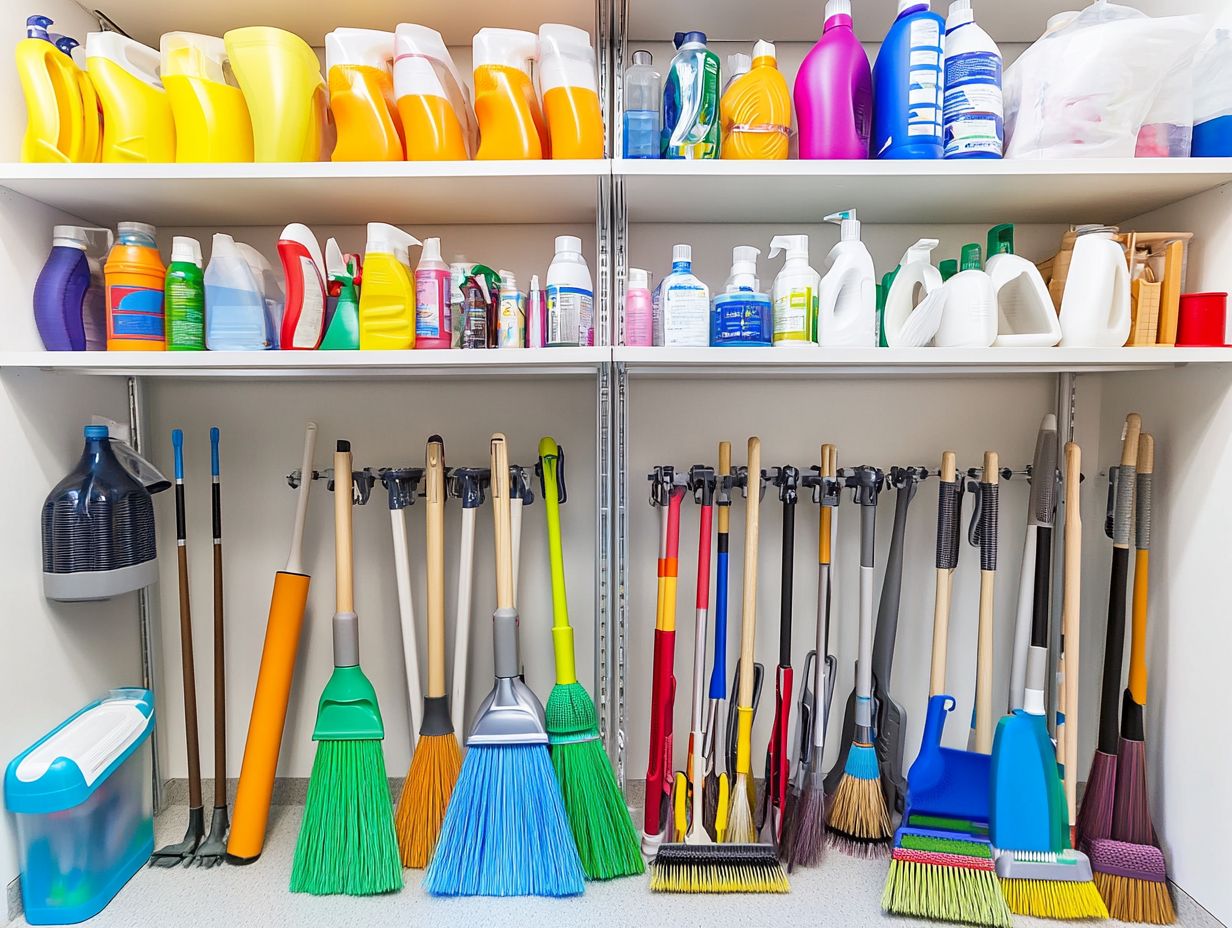
1. How do I properly clean and maintain my cleaning tools before storing them?
To store your cleaning tools with care, it is important to first clean and maintain them properly. This will help extend their lifespan and prevent any bacteria or germs from accumulating. Use warm water and soap to clean your tools, making sure to remove any debris or residue. Then, dry them completely before storing them in a cool, dry place like a utility closet. Refer to Organized Overall and publications like Martha Stewart Living for more storage tips.
2. How should I organize my cleaning tools when I store them?
When storing your cleaning tools, it is important to have an organized system in place. This will not only make it easier for you to find the tools you need, but it will also help prevent any damage to the tools. Consider using a peg board, wall-mounted rack, or labeled bins to keep your tools neatly organized. Experts in professional organizing, like those from Huza Home Concepts, recommend proper storage solutions for optimal home organization.
3. How often should I replace my cleaning tools?
The frequency of replacing your cleaning tools depends on the type of tool and how often you use it. For example, sponges should be replaced every 2-3 weeks, while brooms and mops can last for several months. Keep an eye out for any signs of wear and tear, and replace tools as needed to ensure they continue to effectively clean your space. Refer to guidelines by OSHA and Rutgers University for maintaining a clean workplace.
4. Can I store all of my cleaning tools together in one place?
Storing all your cleaning tools in one spot might seem convenient. However, certain chemicals and materials can react and create safety hazards. It’s best to keep tools and chemicals in separate places. For organizing tips, check out BHG and FreshSpace Cleaning.
5. How can I protect my cleaning tools from getting damaged during storage?
To keep your cleaning tools safe, make sure they are completely dry before storing them. Avoid damp areas and extreme temperatures. Using protective covers helps prevent scratches and dents. Follow Daily cleaning routines from Sort and Sweet and Branch Basics to maintain your tools’ quality.
6. Is it necessary to clean my storage area for cleaning tools regularly?
Yes! Cleaning your storage area regularly keeps your tools in great shape. Dust and debris can collect over time, affecting your tools’ performance. Wipe down the area with a damp cloth, then ensure it is dry before returning your tools. For great tips, check out Mary Cornetta from Sort and Sweet and resources like The New York Times.
